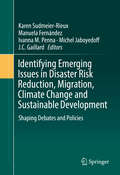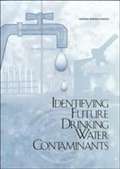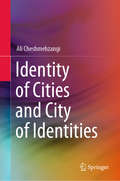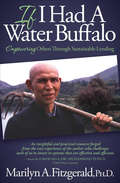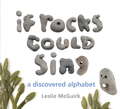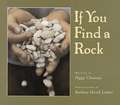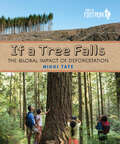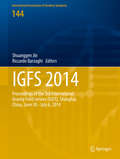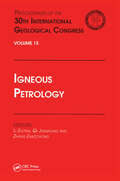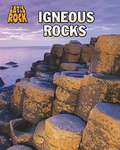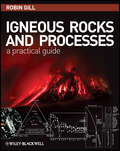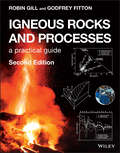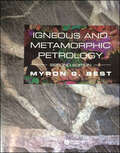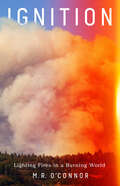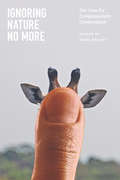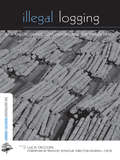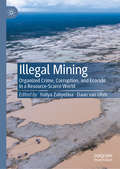- Table View
- List View
Identifying Emerging Issues in Disaster Risk Reduction, Migration, Climate Change and Sustainable Development
by Karen Sudmeier-Rieux Manuela Fernández Ivanna M. Penna Michel Jaboyedoff J. C. GaillardThe proposed book is a timely contribution to researchers, students, scholars and policy makers in the fields of environment, human geography, development and disaster studies towards providing a more comprehensive grasp of contemporary development issues. Contributions include well-known practitioners and scientists that provide theoretical discussions as well as field observations regarding climate change adaptation, migration, disaster risk reduction and sustainable development linkages from around the world. One of the main barriers to furthering our understanding about the inter-linkages between these forces of development (or lack thereof) is the silo approach with which we address such issues. In spite of political talk about how to bridge gaps between climate change adaptation and disaster risk reduction, institutional architectures and frameworks maintain the divisions. The goal of this book is to explore these inter-linkages from a number of different geographical, social and natural science angles and contribute to the debate about how to improve disaster risk reduction (DRR) policies and practices, taking into account migration process from a large perspective where both natural and social factors are crucial and mutually "alloyed".
Identifying Future Drinking Water Contaminants
by National Research CouncilWith an increasing population, use of new and diverse chemicals that can enter the water supply, and emergence of new microbial pathogens, the U.S. federal government is faced with a regulatory dilemma: Where should it focus its attention and limited resources to ensure safe drinking water supplies for the future?Identifying Future Drinking Water Contaminants is based on a 1998 workshop on emerging drinking water contaminants. It includes a dozen papers that were presented on new and emerging microbiological and chemical drinking water contaminants, associated analytical and water treatment methods for their detection and removal, and existing and proposed environmental databases to assist in their proactive identification and regulation.The papers are preceded by a conceptual approach and related recommendations to EPA for the periodic creation of future Drinking Water Contaminant Candidate Lists (CCLs--produced every five years--include currently unregulated chemical and microbiological substances that are known or anticipated to occur in public water systems and that may pose health risks).
Identity of Cities and City of Identities
by Ali CheshmehzangiThis book explores the hybridity of urban identities in multiple dimensions and at multiple scales, how they form as catalysts and mechanisms for urban transitions, and how they develop as city branding strategies and urban regeneration methods. Due to rapid globalisation, the notion of identity has become scarcer, more fragile, and inarguably more important. Given the significance of place and displacement for contemporary everyday life, and the continuous advancement of technologies, identifying relations and values that define humans and their environments in various ways has become crucial.Divided into seven chapters, this book provides extensive coverage of ‘urban identity’, an often-overlooked topic in the fields of urbanism, urban geography, and urban design. It approaches the topic from a novel dual perspective, by exploring cities with tangible commonalities and shared strategies for refining their identities, and by highlighting cities and urban environments characterised by multiple identities. Based on a decade of research in this field, the book provides a multi-disciplinary perspective on urban identity. In addition to comprehensive information for students, it offers a key reference guide for urbanists, urban designers and geographers, architectural and urban practitioners, decision-makers, and governing bodies involved in urban development strategies.
If Bees Disappeared (If Animals Disappeared #1)
by Lily WilliamsWhat would happen if bees disappeared? Find out in this fourth book from Lily Williams in the award-winning If Animals Disappeared Series that imagines the consequences of a world without bees.The rolling hills and lush climate of Kent, England are home to many creatures.These creatures are fluffy, sneaky, spikey, and ... small, like the bee.Though bees are small, their importance is BIG. Today there are over 250,000 species of bees but all of them are in danger. Because of disease, pesticide exposure, lack of foraging habitats, and poor nutrition, entire honey bee hives are dying.What would happen if bees disappeared completely?Artist Lily Williams explores how such a loss would effect not just bees' environment, but the world as a whole in this poignant, beautiful book about the importance of our most important bees.
If Elephants Disappeared (If Animals Disappeared)
by Lily WilliamsWhat would happen if elephants disappeared? Trace the repercussions of a world without elephants in writer and illustrator Lily Williams' third picture book about loss and conservation.The Congolese forest is home to many types of animals. Some are strong. Some are slippery.Some are loud.And some, like the elephant, are BIG.The elephant has become synonymous with the image of African wildlife. They can grow over 10 feet tall and eat up to 300 pounds a day. While these giants are beloved figures in movies and zoos, they also play a large role in keeping the forest ecosystem healthy.Unfortunately, poachers are hunting elephants rapidly to extinction for their ivory tusks, and that could be catastrophic to the world as we know it.
If I Had A Water Buffalo: Empowering Others Through Sustainable Lending
by Marilyn A. FitzgeraldAn expert in fighting global poverty shares lessons from her travels and outlines a path to help impoverished people achieve self-sufficiency.Dr. Marilyn A. Fitzgerald has travelled the globe working to end world poverty through humanitarian aid and microfinance. With her unique opportunity to observe what works and what doesn’t, she set out to find a system that not only provides resources, but helps people thrive—a way that helps people build a foundation of dignity and self-determination.If I Had a Water Buffalo details Fitzgerald’s journey of discovery from the remote villages and cities of Indonesia to Eastern Europe, South America, Bangladesh, and beyond. Fitzgerald begins her book by recounting the ongoing cycle of visiting international humanitarian projects and then returning home to solicit the funds and resources needed to support those projects. Then, during a trip to a village in Indonesia, a man’s request for a water buffalo inspired Fitzgerald to find a better way.In If I Had a Water Buffalo, Fitzgerald shares the lessons she learned both in academia and in the world—lessons that can be adopted by businesses, institutions, schools, parents, and individuals seeking to help lift people around the world out of poverty.
If Polar Bears Disappeared (If Animals Disappeared)
by Lily WilliamsThe freezing ecosystem in the far north of the globe is home to many different kinds of animals. They can beStrong, like a walrusTough, like a lemmingResilient, like an arctic foxBut no arctic animal is as iconic as the polar bear.Unfortunately, the endangered polar bear is threatened with extinction due to rapid climate change that is causing the ice where it hunts/lives to melt at an alarming rate. If Polar Bears Disappeared uses accessible, charming art to explore what would happen if the sea ice melts, causing the extinction of polar bears, and how it would affect environments around the globe.
If Rocks Could Sing: A Discovered Alphabet
by Leslie McguirkAmazing rocks, found on a stretch of beach near the author's home, comprise this unique alphabet book. A is for Addition, and there are rocks in the shape of real numbers, too. B is for Bird, and there is a bird rock on a nest with an egg. G is for Ghosts, and there is a host of rocks that look like ghosts! Children and adults alike will pore over these fascinating rocks, and will be inspired collect their own.From the Hardcover edition.
If Sharks Disappeared (If Animals Disappeared)
by Lily WilliamsA healthy ocean is home to many different kinds of animals. They can be big, like a whale, tiny, like a shrimp, and even scary, like a shark. Even though sharks can be scary, we need them to keep the oceans healthy. Unfortunately, due to overfishing, many shark species are in danger of extinction, and that can cause big problems in the oceans and even on land. What would happen if this continued and sharks disappeared completely?Artist Lily Williams explores how the disappearance would affect other animals across the whole planet in this clever book about the importance of keeping sharks, and our oceans, healthy.
If Tigers Disappeared (If Animals Disappeared)
by Lily WilliamsWhat would happen if tigers disappeared? Find out in this fifth book in the award-winning If Animals Disappeared series that imagines the consequences of a world without tigers.Deep in the Biligirirangana Hills in India, a fierce creature roams. This landscape is home to animals that are slithery smart hidden and....LOUD like the roar of a tiger.There are nine subspecies of tigers, but three are now extinct. They play a very important role in keeping nature in balance. But, due to expanding human populations, poaching, and more, they’re in danger. What would happen if tigers disappeared completely? Join Lily Williams as she tracks the devastating reality of what our world might look like without tigers.
If You Find a Rock
by Peggy ChristianCelebrates the variety of rocks that can be found, including skipping rocks, chalk rocks, and splashing rocks.
If You Find a Rock (Into Reading, Read Aloud Module 2 #3)
by Peggy Christian Barbara LemberNIMAC-sourced textbook
If You Want to Visit a Sea Garden
by Kay WeismanDiscover the wonder of ancient sea gardens on the Northwest Coast Sea gardens have been created by First Peoples on the Northwest coast for more than three thousand years. These gardens consist of stone reefs that are constructed at the lowest tide line, encouraging the growth of clams and other marine life on the gently sloped beach. This lyrical story follows a young child and an older family member who set out to visit a sea garden early one morning, as the lowest tides often occur at dawn. After anchoring their boat, they explore the beach, discover the many sea creatures that live there, hear the sputtering of clams and look closely at the reef. They reflect on the people who built the wall long ago, as well as those who have maintained it over the years. After digging for clams, they tidy up the beach, then return home.An author’s note provides further information about sea gardens (also known as clam gardens), which yield a reliable food source and have been traditional places of learning. They have been found along the Pacific coast, from Alaska to British Columbia to Washington State, and some of these gardens are being restored today.The manuscript has been vetted and approved by the scientists of the Clam Garden Network and Kwaxsistalla Wathl’thla Clan Chief Adam Dick. Roy Henry Vickers, whose ancestry includes the Tsimshian, Haida and Heiltsuk First Nations, has created hauntingly beautiful images to accompany the text.Key Text Featuresauthor’s noteCorrelates to the Common Core State Standards in English Language Arts:CCSS.ELA-LITERACY.RI.K.2>With prompting and support, identify the main topic and retell key details of a text.CCSS.ELA-LITERACY.RI.K.6Name the author and illustrator of a text and define the role of each in presenting the ideas or information in a text.
If a Tree Falls: The Global Impact of Deforestation (Orca Footprints #18)
by Nikki TateEvery day more of the world’s forests disappear. Trees are cleared for agriculture, lost in wildfires and harvested for the valuable products they supply. Called the lungs of the planet, forests play a critical role in climate moderation. What happens when they’re gone? Are replanting and afforestation efforts helping? In If A Tree Falls: The Global Impact of Deforestation, author Nikki Tate gives an accessible and balanced look at forest practices throughout history, the growth of industry and the fight for preservation. Global deforestation affects us all. Find out what you can do to protect forests today and keep them healthy for future generations.
Igfs 2014
by Shuanggen Jin Riccardo BarzaghiThis proceedings contains a selection of peer-reviewed papers presented at the IAG Scientific Assembly, Postdam, Germany, 1-6 September, 2013. The scientific sessions were focused on the definition, implementation and scientific applications of reference frames; gravity field determination and applications; the observation and assessment of earth hazards. It presents a collection of the contributions on the applications of earth rotations dynamics, on observation systems and services as well as on imaging and positioning techniques and its applications.
Igneous Petrology: Proceedings of the 30th International Geological Congress, Volume 15
by Li Zhaonai; Qi Jianzhong; Zhang ZhaochongThis volume, based on Symposium on Igneous Petrology held during the 30th International Geological Congress, focuses on intraplate magmatism and diversity and complexity of mechanisms of magma formation.
Igneous Rocks
by Chris OxladeIgneous Rocks looks at how igneous rocks form, change, move, evolve, erode, and are recycled around the world.
Igneous Rocks and Processes
by Robin GillThis book is for geoscience students taking introductory or intermediate-level courses in igneous petrology, to help develop key skills (and confidence) in identifying igneous minerals, interpreting and allocating appropriate names to unknown rocks presented to them. The book thus serves, uniquely, both as a conventional course text and as a practical laboratory manual.Following an introduction reviewing igneous nomenclature, each chapter addresses a specific compositional category of magmatic rocks, covering definition, mineralogy, eruption/ emplacement processes, textures and crystallization processes, geotectonic distribution, geochemistry, and aspects of magma genesis. One chapter is devoted to phase equilibrium experiments and magma evolution; another introduces pyroclastic volcanology. Each chapter concludes with exercises, with the answers being provided at the end of the book.Appendices provide a summary of techniques and optical data for microscope mineral identification, an introduction to petrographic calculations, a glossary of petrological terms, and a list of symbols and units. The book is richly illustrated with line drawings, monochrome pictures and colour plates.Additional resources for this book can be found at: http://www.wiley.com/go/gill/igneous.
Igneous Rocks and Processes: A Practical Guide
by Robin Gill Godfrey FittonIGNEOUS ROCKS AND PROCESSES A practical introduction to igneous petrology for students and practitioners The newly revised Second Edition of Igneous Rocks and Processes: A Practical Guide, delivers an authoritative introduction to igneous petrology and helps students to develop key skills and confidence in identifying igneous materials and in naming and interpreting unknown igneous rocks presented to them. It serves as both a conventional course text and a practical laboratory manual. The authors review igneous nomenclature and subsequently describe specific compositional categories of magmatic rocks. Each chapter covers definitions, mineralogy, eruption and emplacement processes, textures and crystallization processes, geotectonic distribution, geochemistry, and aspects of magma genesis. Additional chapters address phase equilibrium experiments and physical volcanology. This latest edition offers readers extensively updated chapters, as well as access to a companion website with supplementary material. It also provides: Thorough introductions to magmas, magmatic rocks, and magma differentiation Exercises for each chapter, with answers provided at the end A detailed summary of techniques and optical data for mineral identification using a polarizing microscope An introduction to petrographic calculations and an extensive glossary Perfect for geoscience students taking courses in igneous petrology, Igneous Rocks and Processes: A Practical Guide, second edition will also earn a place in the libraries of postgraduate students and researchers in the field.
Igneous and Metamorphic Petrology
by Myron G. BestIgneous and metamorphic petrology has over the last twenty years expanded rapidly into a broad, multifaceted and increasingly quantitative science. Advances in geochemistry, geochronology, and geophysics, as well as the appearance of new analytical tools, have all contributed to new ways of thinking about the origin and evolution of magmas, and the processes driving metamorphism. This book is designed to give students a balanced and comprehensive coverage of these new advances, as well as a firm grounding in the classical aspects of igneous and metamorphic petrology. The emphasis throughout is on the processes controlling petrogenesis, but care is taken to present the important descriptive information so crucial to interpretation. One of the most up-to-date synthesis of igneous and metamorphic petrology available. Emphasis throughout on latest experimental and field data. Igneous and metamorphic sections can be used independently if necessary.
Ignition: Lighting Fires in a Burning World
by M.R. O'ConnorA work of on-the-ground reporting into the science of, and cultural ideas around, wildfires and fire management that challenges the ethos of the conservation movement, offering a hopeful vision of the connection between humans and our environment. In a riveting investigation of the science and ecology of wildfires, journalist M.R. O'Connor ventures into some of the oldest, most beautiful, and remote forests in North America to explore the powerful and ancient relationship between trees, fires, and humans. Along the way, she describes revelatory research in the fields of paleobotany and climate science to show how the world's forests have been shaped by fire for hundreds of millions of years. She also reports on the compelling archeological evidence emerging from the field of ethnoecology that proves how, until very recently, humans were instigators of forest fires, actively molding and influencing the ecosystems around them by inserting themselves into the loop of a natural biological process to start &“good fires.&” As she weaves together first-hand reportage with research and cultural insights, O'Connor also embeds on firelines alongside firefighters and &“pyrotechnicians.&” These highly trained individuals are resurrecting the practice of prescribed burning in an effort to sustain fire-dependent forest ecologies and prevent the catastrophic wildfires that are increasing in frequency and intensity as a result of global warming. Hailing from diverse backgrounds including state and federal agencies, scientific laboratories, and private lands and tribal nations, these fire starters are undertaking a radical and often controversial effort to promote, protect, and expand the responsible use of fire to restore ecological health to landscapes. At the heart of Ignition is a discussion about risk and how our relationship to it as a society will determine our potential to survive the onslaught of climate change.
Ignoring Nature No More: The Case for Compassionate Conservation
by Marc BekoffFor far too long humans have been ignoring nature. As the most dominant, overproducing, overconsuming, big-brained, big-footed, arrogant, and invasive species ever known, we are wrecking the planet at an unprecedented rate. And while science is important to our understanding of the impact we have on our environment, it alone does not hold the answers to the current crisis, nor does it get people to act. In Ignoring Nature No More, Marc Bekoff and a host of renowned contributors argue that we need a new mind-set about nature, one that centers on empathy, compassion, and being proactive. This collection of diverse essays is the first book devoted to compassionate conservation, a growing global movement that translates discussions and concerns about the well-being of individuals, species, populations, and ecosystems into action. Written by leading scholars in a host of disciplines, including biology, psychology, sociology, social work, economics, political science, and philosophy, as well as by locals doing fieldwork in their own countries, the essays combine the most creative aspects of the current science of animal conservation with analyses of important psychological and sociocultural issues that encourage or vex stewardship. The contributors tackle topics including the costs and benefits of conservation, behavioral biology, media coverage of animal welfare, conservation psychology, and scales of conservation from the local to the global. Taken together, the essays make a strong case for why we must replace our habits of domination and exploitation with compassionate conservation if we are to make the world a better place for nonhuman and human animals alike.
Ignoring Nature No More: The Case for Compassionate Conservation
by Marc BekoffFor far too long humans have been ignoring nature. As the most dominant, overproducing, overconsuming, big-brained, big-footed, arrogant, and invasive species ever known, we are wrecking the planet at an unprecedented rate. And while science is important to our understanding of the impact we have on our environment, it alone does not hold the answers to the current crisis, nor does it get people to act. In Ignoring Nature No More, Marc Bekoff and a host of renowned contributors argue that we need a new mind-set about nature, one that centers on empathy, compassion, and being proactive. This collection of diverse essays is the first book devoted to compassionate conservation, a growing global movement that translates discussions and concerns about the well-being of individuals, species, populations, and ecosystems into action. Written by leading scholars in a host of disciplines, including biology, psychology, sociology, social work, economics, political science, and philosophy, as well as by locals doing fieldwork in their own countries, the essays combine the most creative aspects of the current science of animal conservation with analyses of important psychological and sociocultural issues that encourage or vex stewardship. The contributors tackle topics including the costs and benefits of conservation, behavioral biology, media coverage of animal welfare, conservation psychology, and scales of conservation from the local to the global. Taken together, the essays make a strong case for why we must replace our habits of domination and exploitation with compassionate conservation if we are to make the world a better place for nonhuman and human animals alike.
Illegal Logging: Law Enforcement, Livelihoods and the Timber Trade
by Luca Tacconi'This book carefully blends conceptual insights with extensive empirical evidence to navigate the reader through an issue that is still poorly understood [and is] a valuable reference for the development practitioner to understand the fundamental causes of illegal logging, its myriad consequences and the policy choices available to address the problem' Nalin Kishor, Forest Law Enforcement and Governance Coordinator, The World Bank 'An excellent resource for those working to conserve and sustainably manage forests worldwide. It offers an extensive and comprehensive study of illegal logging, bringing together the knowledge and views of experts who examine its roots and social, economic and environmental implications. One of its important contributions is to show that, unless coupled with reform of forestry regulations to take into account local people, law enforcement to curb illegal logging can negatively impact them. Therefore, any effective and fair approach to the problem needs to involve governments, forestry operators and local communities alike' Gonzalo Oviedo, Senior Social Policy Advisor, IUCN In many countries illegal logging now accounts for a large share of the harvest. Once cut, illegal logs feed an insatiable demand for exotic hardwoods in developed and developing countries. The result has been loss of both revenue and biodiversity, and consequently the issue has risen to the top of the global forest policy agenda as one of the major threats to forests, and donors and national governments are starting to develop initiatives to control illegal logging. Yet for such a massive illegal trade, there is surprisingly limited knowledge available as to the major causes of illegal logging and its impacts on biodiversity, people and livelihoods and national economies, and thus plenty of speculation and action without evidence. It is clear that while illegal logging does have negative impacts, it also, controversially, and perhaps paradoxically, benefits many stakeholders, including local communities. This book, written by the world's foremost experts, examines the key issues including law and enforcement, supply and demand, corruption, forest certification, poverty, local livelihoods, international trade and biodiversity conservation. It includes key case studies from forest-rich hotspots in North, South and Central America, equatorial Africa and Indonesia. While there are clearly no easy answers, this book sorts fact from fiction and explores the many dimensions of the causes, impacts and implications for forests, people, livelihoods and forest policy. Published with CIFOR
Illegal Mining: Organized Crime, Corruption, and Ecocide in a Resource-Scarce World
by Daan Van Uhm Yuliya ZabyelinaThis book provides a comprehensive analysis of the illegal extraction of metals and minerals from the perspectives of organized crime theory, green criminology, anti-corruption studies, and victimology. It includes contributions that focus on organized crime-related offences, such as drug trafficking and trafficking in persons, extortion, corruption and money laundering and sheds light on the serious environmental harms caused by illegal mining. Based on a wide range of case studies from the Amazon rainforest through the Ukrainian flatlands to the desert-like savanna of Central African Republic and Australia’s elevated plateaus, this book offers a unique insight into the illegal mining business and the complex relationship between organized crime, corruption, and ecocide. This is the first book-length publication on illegal extraction, trafficking in mined commodities, and ecocide associated with mining. It will appeal to scholars working on organized crime and green crime, including criminologists, sociologists, anthropologists, and legal scholars. Practitioners and the general public may welcome this comprehensive and timely publication to contemplate on resource-scarcity, security, and crime in a rapidly changing world.
